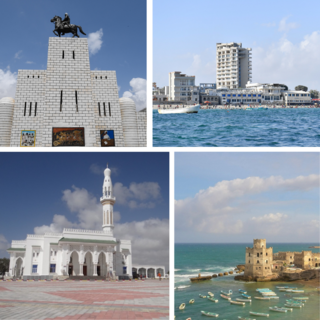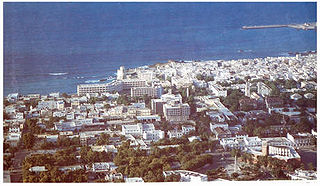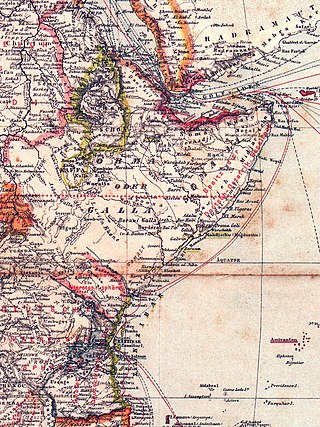
Mogadishu currency was an old coinage system minted by the medieval Sultanate of Mogadishu.

Mogadishu currency was an old coinage system minted by the medieval Sultanate of Mogadishu.
In order to facilitate regional trade, the Mogadishu Sultanate began minting its own coins, a move which had the effect of centralizing its commercial hegemony. The currency bears the names of 23 successive Sultans of Mogadishu. Some coins also adopted the style of the extant Fatimid and Ottoman currencies. For trade, the Ajuran Empire minted its own Ajuran currency. [1] It also utilized the Mogadishan currency originally minted by the Sultanate of Mogadishu, which later became incorporated into the Ajuran Empire during the 13th century. [2]
Mogadishan coins were in widespread circulation. Pieces have been found as far away as the present-day United Arab Emirates, where a coin bearing the name of a 15th-century Somali Sultan Ali b. Yusuf of Mogadishu was excavated. Over the course of three archaeological expeditions in Warsheikh between 1920 and 1921, Enrico Cerulli also uncovered coins from the medieval Sultans of Mogadishu. They were deposited in the Scuola Orientale of the University of Rome, but were later lost in World War II. According to Cerulli, similar coins were found in the village of Mos (Moos), located about 14 km to Warsheikh's northwest. Freeman-Grenville (1963) also record another discovery of ancient coins in the latter town. [3] During excavation in Iraq in 1971, a copper piece was discovered baring the name of Sultan of Mogadishu Ali ibn Yusuf. [4] Bronze coins belonging to the Sultans of Mogadishu have also been found at Belid near Salalah in Dhofar. [5]
Somalia, officially the Federal Republic of Somalia and formerly known as the Somali Democratic Republic, is a country located in the Horn of Africa. The country was an important centre for commerce with the rest of the ancient world, and according to most scholars, it is among the most probable locations of the fabled ancient Land of Punt. During the Middle Ages, several powerful Somali states and port towns dominated the regional trade, the Mogadishu Sultanate and Ajuran Sultanate both centered around the port town Mogadishu, but also the port towns of Barawe and Merca.

Mogadishu, locally known as Xamar or Hamar, is the capital and most populous city of Somalia. The city has served as an important port connecting traders across the Indian Ocean for millennia, and has an estimated urban population of 2,610,483. Mogadishu is located in the coastal Banadir region on the Indian Ocean, which unlike other Somali regions, is considered a municipality rather than a maamul goboleed.

Merca is the capital city of the Lower Shebelle province of Somalia, a historic port city in the region. It is located approximately 109 km (68 mi) to the southwest of the nation's capital Mogadishu. Merca is the traditional home territory of the Bimal clan and was the center of the Bimal revolt.

The Hawiye is the largest Somali clan family. Members of this clan traditionally inhabit central and southern Somalia, Somaliland, Djibouti, Ethiopia and Kenya. They are also the majority in the capital city, Mogadishu.
Hobyo, is an ancient port city in Galmudug state in the north-central Mudug region of Somalia.

The Ajuran Sultanate, also natively referred to as Ajuuraan, and often simply Ajuran, was a Somali Empire in the Middle Ages in the Horn of Africa that dominated the trade in the northern Indian ocean. They belonged to the Somali Muslim sultanate that ruled over large parts of the Horn of Africa in the Middle Ages. Through a strong centralized administration and an aggressive military stance towards invaders, the Ajuran Empire successfully resisted an Oromo incursion from the west and a Portuguese incursion from the east during the Gaal Madow and the Ajuran-Portuguese wars. Trading routes dating from the ancient and early medieval periods of Somali maritime enterprise were strengthened or re-established, and foreign trade and commerce in the coastal provinces flourished with ships sailing to and coming from many kingdoms and empires in East Asia, South Asia, Europe, the Near East, North Africa and East Africa.

The Sultanate of Hobyo, also known as the Sultanate of Obbia, was a 19th-century Somali Sultanate in present-day northeastern and central Somalia and eastern Ethiopia. It was established in 1878 by Yusuf Ali Kenadid.
Warsheikh is an administration center and coastal town of Warsheikh district. Warsheikh is located in the southeastern Middle Shabelle region of Hirshabelle State of Somalia. On the south, Warsheikh is bordered by the Banadir region, and on the north Adale District.

Mogadishu is the largest city in Somalia and the nation's capital. Located in the coastal Benadir region on the Indian Ocean, the city has served as an important port for centuries.
Afgooye is a town in the southeastern Somalia Lower Shebelle region of Somalia. It is the center of the Afgooye District. Afgooye is the third largest city of Southwest State. Afgooye is one of the oldest towns on the lower Shebelle valley, 30 kilometers north of Mogadishu. Afgooye is the site of Lafoole college, the first college of education in Somalia, built on the site of the battle of Lafoole of 1896. Afgooye is also known for the Istunka, the annual "stick fight" carnival commemorating the New Year in the riverine region. It was a trade center for the Silcis Dynasty in the medieval period then fell under Ajuran rule. Around the late 17th century, Afgooye became the capital of Geledi Sultanate.

Somali architecture is the engineering and designing of multiple different construction types such as stone cities, castles, citadels, fortresses, mosques, temples, aqueducts, lighthouses, towers and tombs during the ancient, medieval and early modern periods in Somalia and other regions inhabited by Somalis, as well as the fusion of Somalo-Islamic architecture with Western designs in contemporary times.

Maritime history of Somalia refers to the seafaring tradition of the Somali people. It includes various stages of Somali navigational technology, shipbuilding and design, as well as the history of the Somali port cities. It also covers the historical sea routes taken by Somali sailors which sustained the commercial enterprises of the historical Somali kingdoms and empires, in addition to the contemporary maritime culture of Somalia.

The military history of Somalia encompasses the major conventional wars, conflicts and skirmishes involving the historic empires, kingdoms and sultanates in the territory of present-day Somalia, through to modern times. It also covers the martial traditions, military architecture and hardware employed by Somali armies and their opponents.

The Sultanate of Mogadishu, also known as the Kingdom of Magadazo, was a medieval Somali sultanate centered in southern Somalia. It rose as one of the pre-eminent powers in the Horn of Africa under the rule of Fakhr al-Din before becoming part of the powerful and expanding Ajuran Sultanate in the 13th century. The Mogadishu Sultanate maintained a vast trading network, dominated the regional gold trade, minted its own currency, and left an extensive architectural legacy in present-day southern Somalia.

Somali nationalism is centered on uniting the Somali people who share a common language, religion, culture and ethnicity, and as such constitute a nation unto themselves. The ideology's earliest manifestations in the medieval era are traced to the Adalites whilst in the contemporary era its often traced back to SYL, the first Somali nationalist political organization to be formed was the Somali National League (SNL), established in 1935 in the former British Somaliland protectorate. In the country's northeastern, central and southern regions, the similarly-oriented Somali Youth Club (SYC) was founded in 1943 in Italian Somaliland, just prior to the trusteeship period. The SYC was later renamed the Somali Youth League (SYL) in 1947. It became the most influential political party in the early years of post-independence Somalia. The Somali guerilla militia Al-Shabab is noteworthy for incorporating Somali nationalism into its Islamist ideology.

This is a list of Somali aristocratic and court titles that were historically used by the Somali people's various sultanates, kingdoms and empires. Also included are the honorifics reserved for Islamic notables as well as traditional leaders and officials within Somali customary law (xeer), in addition to the nobiliary particles set aside for distinguished individuals.
Ajuran currency was an old coinage system minted in the Ajuran Sultanate. The polity was a Somali Muslim kingdom that ruled over large parts of the Horn of Africa during the Middle Ages. The Ajuran Sultanate maintained an active commercial network with other contemporaneous polities in the Arabian peninsula, Near East and Central Asia. Many ancient bronze coins inscribed with the names of Ajuran Sultans have been found in the coastal Benadir province in southern Somalia, in addition to pieces from the Sultanate's Islamic trading partners in Southern Arabia and Persia.

The Hiraab Imamate, also known as the Yacquubi Dynasty, was a Somali kingdom that ruled parts of the Horn of Africa during the 16th century till the 19th century until it was incorporated into Italian Somaliland. The Imamate was governed by the Hiraab Yacquub Dynasty. It was founded by Imam Omar who successfully rebelled and defeated the Ajuran and established an independent kingdom.

The Muẓaffarids were a Muslim dynasty that ruled the Banaadir coast with their capital at Mogadishu from the late 15th or early 16th century until around 1624 or possibly as late as 1700. They were of Persian extraction that mixed with the local Somali population and are related to the Ajuran clan. They were effectively independent, but allied to the more powerful Ajuran Sultanate. They resisted the Portuguese, but occasionally paid them tribute. In the 17th century, the Muẓaffarids were conquered by the Somali Abgaal.

German colonial efforts on the Somali coast were pursued from 1885 to 1890. Representatives of the German East Africa Company signed friendship and protection treaties with local rulers in the coastal cities of Somalia in 1885 and 1886 with the aim of acquiring areas north of Wituland. In 1888 and 1890, respectively, the project, which overlapped with British and Italian claims, was abandoned.